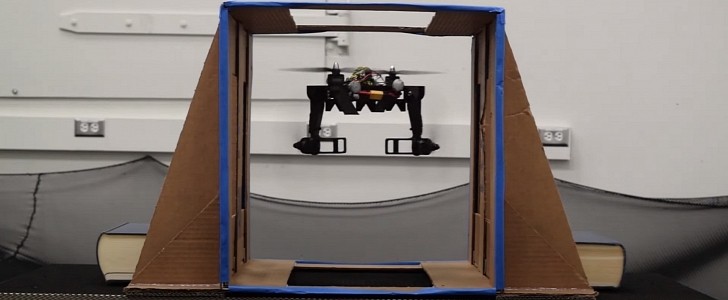As versatile as conventional drones are, their classic design does come with its limitations, especially when the aircraft has to access narrower places, traverse small passages, and so on. HiPeRLab scientists at Berkeley University have come up with a quadcopter design that opens a world of new possibilities.
Unlike with most quadcopters, the new design allows the drone to change its shape mid-flight, without using any electric actuators, which would take up additional battery power and make the structure more complicated. Instead, researchers at the HiPeRLab (High Performance Robotics Lab), which focuses on UAS (unmanned aerial systems), made it possible for the quadcopter to morph in the air using unactuated hinges.
Their modified drone is called a Midair-Reconfigurable Quadcopter and it can fold or unfold its arms without requiring any additional sensors or components beyond the four motors you typically find in such a flying device. These passive hinges allow each of the drone’s arms to rotate freely, folding and unfolding during flight, by reducing or reversing thrust forces, depending on what it wants to achieve.
The Midair-Reconfigurable Quadcopter can hover with two of its opposing arms folded, which makes the drone capable of passing through tighter spaces that would otherwise be inaccessible, such as narrow tunnels or passages, etc. In this configuration, the quadcopter can also grab things, as you can see in the video below this article.
But the drone can also use the unactuated hinges to perch on hanging wires, by folding all four arms and shifting the center of its mass below its point of contact, thus helping the aircraft maintain its balance.
By reversing the direction of thrust for all four propellers you can also fold all four arms simultaneously so that the quadcopter can traverse narrow gaps in projectile motion (free-fall). When changing back the rotation direction of the thrust, the arms are once again unfolded.
HiPeRLab researchers don’t specify anything on how they plan to put to good use their folding quadcopter. This isn’t a recent study either, as it was first published in 2019.
Their modified drone is called a Midair-Reconfigurable Quadcopter and it can fold or unfold its arms without requiring any additional sensors or components beyond the four motors you typically find in such a flying device. These passive hinges allow each of the drone’s arms to rotate freely, folding and unfolding during flight, by reducing or reversing thrust forces, depending on what it wants to achieve.
The Midair-Reconfigurable Quadcopter can hover with two of its opposing arms folded, which makes the drone capable of passing through tighter spaces that would otherwise be inaccessible, such as narrow tunnels or passages, etc. In this configuration, the quadcopter can also grab things, as you can see in the video below this article.
But the drone can also use the unactuated hinges to perch on hanging wires, by folding all four arms and shifting the center of its mass below its point of contact, thus helping the aircraft maintain its balance.
By reversing the direction of thrust for all four propellers you can also fold all four arms simultaneously so that the quadcopter can traverse narrow gaps in projectile motion (free-fall). When changing back the rotation direction of the thrust, the arms are once again unfolded.
HiPeRLab researchers don’t specify anything on how they plan to put to good use their folding quadcopter. This isn’t a recent study either, as it was first published in 2019.







